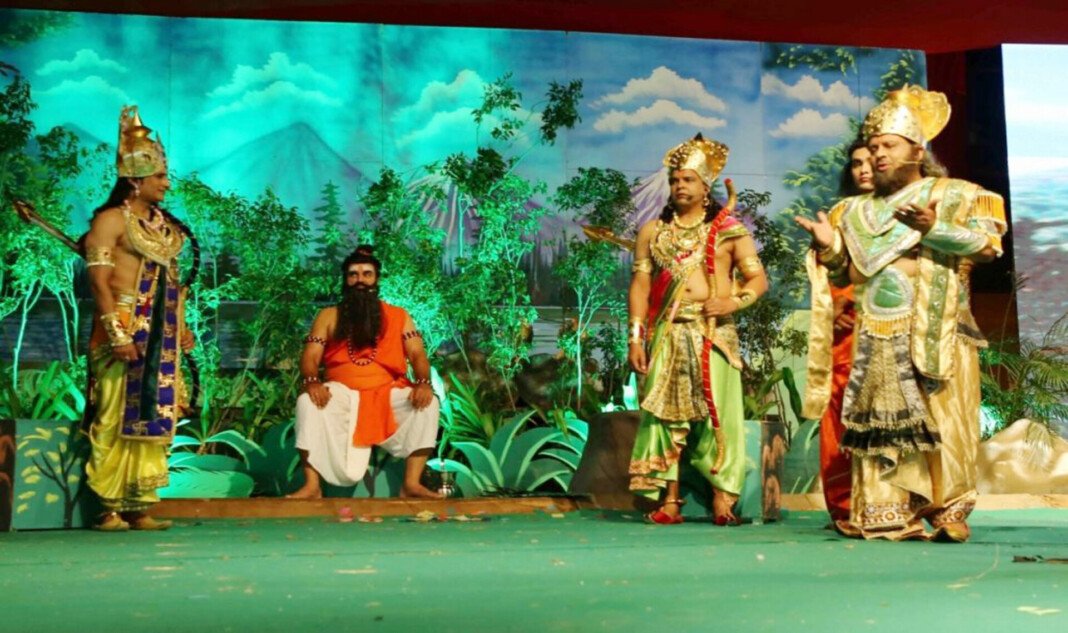By: Dr Satyavan Saurabh
Ramlila, literally meaning “Rama’s play”, is a performance of the epic Ramayana that combines songs, narration, singing, and dialogue in a series of scenes. It is performed throughout North India every year in autumn during the festival of Dussehra as per the ritual calendar. The most representative are the Ramlilas of Ayodhya, Ramnagar and Banaras, Vrindavan, Almora, Sattna, and Madhubani. This staging of the Ramayana is based on Ramcharitmanas, one of the most popular storytelling art forms in the north of the country. This sacred text, dedicated to the glory of Rama, the hero of Ramayana, was composed in Hindustani in the sixteenth century by Tulsidas to make the Sanskrit epic available to all. Most Ramlilas narrate the episodes of Ramcharitmanas through a series of performances lasting ten to twelve days, but some, like that of Ramnagar, often last for an entire month. Festivals are organized in hundreds of hamlets, towns, and villages during the festival of Dussehra, celebrating Rama’s return from exile. Ramlila commemorates the war between Rama and Ravana and involves a series of dialogues between gods, sages, and believers. Even in India, there is no evidence of historical staging of Ramlila before Christ.
But in 1500 AD, when Goswami Tulsidas (1497–1623) portrayed the character of Lord Ram in ‘Shri Ramcharit Manas’ in the colloquial language ‘Awadhi’, Ramlila started being staged across the country, especially in North India, through this epic. Put. It is believed that the disciples of Goswami Tulsidas staged the initial Ramlila (Kashi, Chitrakoot, and Awadh) on the story and dialogues of Ramcharit Manas. According to historians, stage Ramlila started in the country at the beginning of the 16th century.
Earlier, only scripture-based staging of Ram Baraat and Rukmini’s marriage used to take place. In the year 1783, Kashi King Udit Narayan Singh resolved to organize Ramlila in Ramnagar every year. It has been written in Bharat Muni’s ‘Natyasastra’ regarding the origin of drama. The origin of ‘Natyasastra’ is considered to be between 500 BC and 100 AD.
According to Natyashastra, the message can be effectively conveyed to the common people through plays, especially folk drama. Ramlila, taking place in every street and village across India, has been accepted as a genre of these folk theatre forms. Ramlila, which presents the story of Ram in the form of a drama on the stage, actually has such diverse styles on the lines of ‘Hari Anant Hari Katha Ananta’.
Ramlila has a different specialty in different languages, dialects, social places, and folk songs from literary works. The effect of this is also visible in its staging. Only in Uttar Pradesh, the staging of Ramlilas of historical Ramnagar, Ramlila of Ayodhya, Chitrakoot, Assi Ghat (Ramlila of Varanasi), Allahabad and Lucknow has its style and specialty. Maybe that is why this phrase has become popular… ‘Apni-Apni Ramkahani’. The dramatic effect of Ramlila arises from the sequence of images representing the climax of each scene. The audience is invited to participate in the songs and narration. Ramlila brings together the entire population without distinction of caste, religion, or age. All the villagers spontaneously participate, playing roles or taking part in a variety of related activities, such as mask and costume making, make-up, preparing mannequins, and lighting.
However, the development of communication media, especially television serials, is leading to a decline in the viewership of Ramlilas, and hence Ramlilas are losing their major role of bringing people and communities together. The glamour of modernity has separated the new generation from our culture, civilization, and values. The new generation has limited itself to the world of the internet, laptop, and mobile. He is no longer concerned with the outside world. Today the new generation is forgetting our traditional Teej festivals. These people have started considering fair, Ramlila, or other cultural programs as a waste of time. As a result, there have been changes in the methods of our programs and the spirit has changed.
Serious issues like obscene dances of bar girls being organized by the organizers during Ramlila in small towns and villages for their financial gain have become a matter of concern today. There is a need to struggle to maintain religiosity in the era of continuously decreasing social consciousness and degradation of traditional cultural values. Today’s decadent times reflect the conflict between faith in the ancient and holy Hindu scripture Ramayana and the powerful people of the society who exploit Ramlila for their financial and personal gains by including obscene dances to attract the audience. When faith is mixed with obscenity, it not only becomes a cause for ridicule but also hurts the sentiments of the majority of people. The character of Maryada Purushottam Ram gives the message of love, generosity, respect and goodwill to the society. But alas, Ramlila, which presents the character and ideals of Ram, has in today’s time become a means of serving obscenity. Shri Ram is the ideal of all of us. It is completely inappropriate to organize obscene dance programs for bar girls during Ramlila. Such programs should be avoided. This sends a wrong message to the society and affects the sentiments of the people. (The author is a poet, freelance journalist and columnist, All India Radio and TV panellist. He can be reached at satywansaurabh3331@gmail.com)







